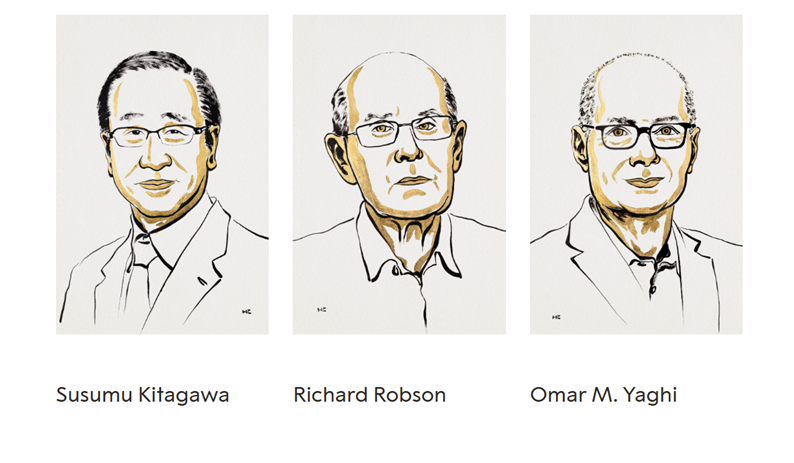The Nobel Prize in Chemistry 2025 has been awarded to three extraordinary scientists Susumu Kitagawa, Richard Robson, and Omar M. Yaghi for their revolutionary work on Metal-Organic Frameworks (MOFs). These materials, often described as “molecular sponges,” are transforming the way we think about chemistry, clean energy, and environmental protection. Their discovery marks one of the most influential scientific advancements of the 21st century a step toward a cleaner, smarter, and more sustainable planet.
What Are Metal-Organic Frameworks?
At the heart of this year’s Nobel Prize in Chemistry 2025 lies a simple yet powerful idea: combining metal atoms with organic molecules to create structures filled with microscopic holes. These are called Metal-Organic Frameworks, or MOFs.
Imagine a sponge at the molecular level but one that can capture gases, store energy, and filter impurities with unmatched precision. MOFs are made by linking metal ions (like zinc, copper, or iron) with organic “linkers” that act like molecular bridges. This results in a crystalline framework full of nano-sized pores.
Because of their high porosity, just one gram of a MOF can have an internal surface area equivalent to a football field! This extraordinary property allows MOFs to trap, separate, or release different kinds of molecules making them valuable for everything from clean energy storage to carbon capture.
The Pioneers Behind the Discovery
The Nobel Committee recognized three scientists whose work laid the foundation for this new branch of chemistry known today as reticular chemistry.
- Richard Robson, from the University of Melbourne in Australia, was among the first to demonstrate that metals and organic molecules could form stable, repeating frameworks. His work in the late 1980s gave birth to the structural principles behind MOFs.
- Susumu Kitagawa, based at Kyoto University in Japan, expanded these frameworks into real-world materials. He proved that MOFs could be flexible, stable, and functional under practical conditions a key milestone in making them useful for industry.
- Omar M. Yaghi, from the University of California, Berkeley, took the concept to a new level. Often called the “father of reticular chemistry,” Yaghi developed methods to design MOFs with predictable structures and properties. His groundbreaking research turned MOFs into a platform for hundreds of new materials used across science and technology.
Together, their contributions transformed Nobel Prize in Chemistry 2025 to an academic idea into a global innovation influencing everything from climate science to medicine.
Why Their Work Matters

This Nobel Prize in Chemistry 2025 isn’t just about molecular beauty — it’s about solving real-world problems. MOFs have already proven their potential to address several global challenges:
Catalysis and Medicine:
MOFs are being used as catalysts to speed up chemical reactions and as delivery vehicles in drug design paving the way for next-generation pharmaceuticals.
Fighting Climate Change:
MOFs can selectively capture carbon dioxide from the air or industrial emissions. This makes them vital for carbon capture and storage (CCS) technologies — a key weapon in reducing global greenhouse gases.
Water Harvesting in Deserts:
Some MOFs can pull water directly from the air, even in extremely dry climates. In places like Africa or the Middle East, this technology could provide clean drinking water from humidity alone.
Clean Energy Storage:
MOFs are also being explored for hydrogen storage, which could revolutionize fuel-cell technology and make renewable energy systems more efficient.
Pollution Control and Filtration:
Because they can trap toxic gases or pollutants, MOFs are ideal for air purification and industrial waste treatment helping create safer environments for humans and nature alike.
The Science Behind the Magic
The secret to MOFs lies in their modularity. Scientists can design them atom-by-atom by choosing different metals and linkers. This flexibility means MOFs can be custom-built for a specific purpose whether that’s storing hydrogen, filtering seawater, or capturing toxic fumes.
In other words, MOFs act like tiny, programmable machines made of molecules. Their power comes not just from their composition, but from the architecture of how those molecules are arranged in space.
Omar Yaghi once described this beautifully: “We can now design materials the way architects design buildings with purpose, precision, and creativity.”
Toward a Sustainable Future
The Nobel Prize in Chemistry 2025 comes at a time when the world urgently needs scientific solutions to global crises from rising temperatures to water shortages. MOFs offer a hopeful vision of what’s possible when science meets sustainability.
Imagine cities where carbon-absorbing filters clean the air, homes powered by hydrogen stored safely in MOFs, and communities in dry regions drinking water extracted from the air. These are not science-fiction ideas they are real projects already underway thanks to MOF research.
This Nobel recognition isn’t just about rewarding past discoveries. It’s a call to action for future innovation to continue exploring how molecular science can help heal the planet.
Human Ingenuity at Its Finest
The journey of Kitagawa, Robson, and Yaghi reflects the best of human curiosity and collaboration. Each scientist worked independently at different times, yet their discoveries intertwined to form a global breakthrough. Their story is a reminder that science has no borders only shared purpose and vision.
The Nobel Committee summed it up perfectly: “Their work gives humankind new tools to design materials that can reshape our future.”
From the lab bench to the environment, the impact of MOFs will be felt for generations. The 2025 Nobel Prize in Chemistry celebrates not just a scientific triumph, but a triumph of imagination proof that with creativity and persistence, even invisible molecules can change the visible world.









